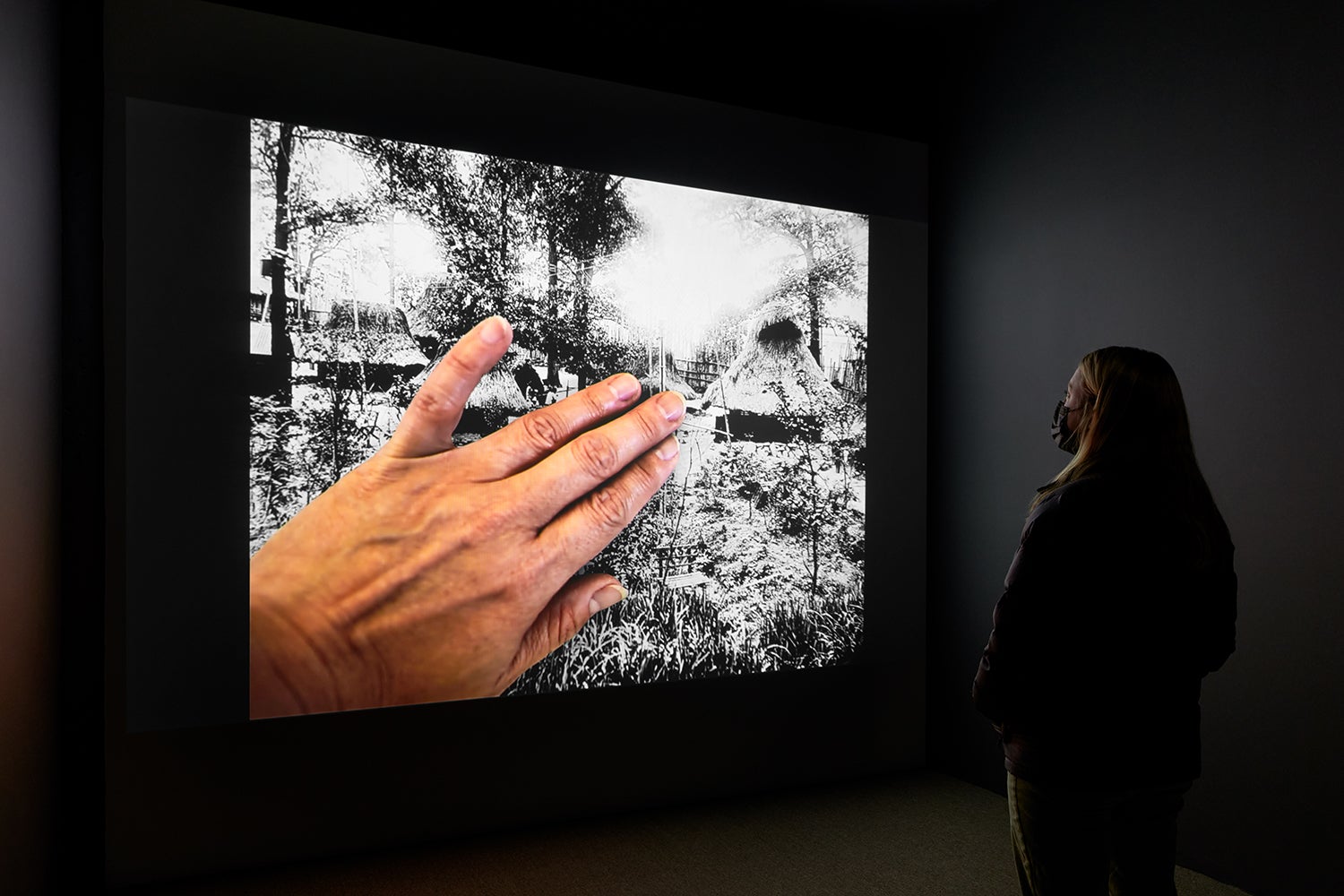In the exhibition White Balance/Color Cast at the Anderson Collection at Stanford University, Oakland-based artist, educator, and Stanford alum Stephanie Syjuco uses photography, video, and installation to examine the construction of U.S. history and colonial practices. Eighteen works installed throughout the museum’s first floor challenge the assumption that images and historical materials are objective or neutral.

Installation shot of Stephanie Syjuco’s “Block Out the Sun,” 2021. Single-channel video with sound. Edition of 3 +2AP. (Image credit: Courtesy of the artist, Catharine Clark Gallery, San Francisco, and RYAN LEE Gallery, New York. Photo: John Janca)
The exhibition opened on Sept. 18 and will be on view through March 5, 2023. The Anderson Collection is always free and open to the public.
“Presenting Stephanie’s work at the Anderson Collection is important for us because she is deeply committed to uncovering and re-presenting histories and making them more visible in relation to people of color,” said Jason Linetzky, director of the Anderson Collection. “She is also not afraid to provoke viewers into questioning their assumptions.”
White Balance/Color Cast derives from Syjuco’s interest in photographic standards, color calibration charts, and the suggestive powers of the medium. The term white balance traditionally refers to the process of removing an image’s color cast, shifting the image to what could be considered a more neutral or accurate representation of, for example, skin, land, and sky. Syjuco uses terms such as “neutral” to question how photography reflects deep-seated biases that position whiteness at its center.
“This is political and activist work, because representation matters.”
—Stephanie Syjuco
“My work is about the slippery spaces between visibility and invisibility, made from the perspective of an American artist who was born in the Philippines, grew up in San Francisco, and takes as their subject matter larger national questions about belonging, citizenship, and the construction of racialized, exclusionary difference,” said Syjuco. “This is political and activist work, because representation matters.”
Syjuco points out that Asian American artists like Ruth Asawa, Martin Wong, Chiura Obata, Carlos Villa, Al-An deSouza, and so many others should not be seen as “accessories to the American project.” She asserts, “We inhabit its centers, and we have always been here.”
The first work that visitors encounter from the exhibition is The Color Shift (Correctional Overlay) (2022), a site-specific installation in the museum’s front window made with color-printed window film and black vinyl. Syjuco asks viewers, seeing the work from both sides of the window, to consider the accuracy and neutrality of their gaze and their role in perpetuating traditional standards. Works in the Wisch Family Gallery include examples from her photo series modeled on historical ethnographic studio portraiture but with a mass-manufactured twist. Syjuco poses draped with goods purchased from American shopping malls and fast fashion houses styled to highlight popular fantasies associated with “ethnic” patterning and costume. The double-take required to comprehend the history and the commentary is where a perspective shift takes place.

Stephanie Syjuco, “Cargo Cults: Head Bundle (Small),” 2016. Pigmented inkjet print. Edition of 15 + 2AP; 21 x 16 inches framed. (Image credit: Courtesy of the artist, Catharine Clark Gallery, San Francisco, and RYAN LEE Gallery, New York)
For Linetzky, hosting a solo exhibition of Syjuco’s work is not only a way to celebrate her selection as the artist honoree at the biennial Museums by Moonlight event sponsored by the two Stanford art museums and held in September, but also an opportunity to support the Cantor Arts Center’s Asian American Art Initiative (AAAI). Syjuco’s work is currently on view in one of the AAAI exhibitions, At Home/On Stage: Asian American Representation in Photography and Film.
“Through her work and social practice, Syjuco aims to help us make better sense of our present and participate in a conversation about shaping our future, either as onlookers contributing to the status quo or as active participants in reconsidering and recasting dominant narratives,” Linetzky said.
Syjuco was born in Manila in 1974 and came to the United States when she was 3 years old. Her work often considers the relationship between her adopted country and the Philippines, which the United States ruled as a colony for nearly 50 years. She is keenly aware of how images have shaped our understanding of history and how the manipulation and interpretation of images have served a long-running, systemic infrastructure of white supremacy.
“Stephanie gives us a creative and intellectual entry point into the issues of erasure, stories told and untold, and how photography and archives frame our understanding of history and culture,” said Aimee Shapiro, director of programming and engagement at the Anderson Collection.
Syjuco earned a BFA from the San Francisco Art Institute in 1995 and an MFA from Stanford in 2005. She is the recipient of a 2014 Guggenheim Fellowship Award, a 2009 Joan Mitchell Painters and Sculptors Award, and a 2020 Tiffany Foundation Award. Her work is collected and exhibited widely throughout the United States. A dedicated educator, she is an associate professor in sculpture at the University of California, Berkeley.
Syjuco will participate in the second day of the Oct. 28-29 AAAI symposium IMU UR2: Art, Aesthetics, and Asian America, and she will be in conversation with Stanford faculty on Nov. 3 at the Anderson Collection. The symposium and the conversation are free and open to the public. Also in conjunction with the AAAI, Syjuco will participate in a winter quarter workshop for students led by Shapiro with guests Aleesa Pitchamarn Alexander and Maggie Dethloff, curators of two of the AAAI exhibitions at the Cantor.